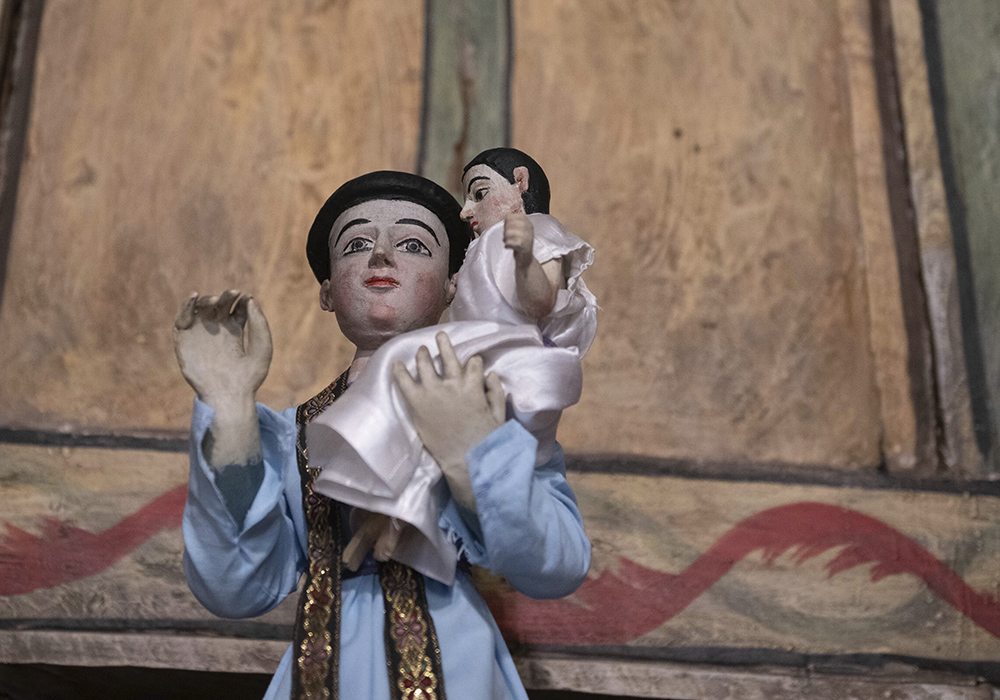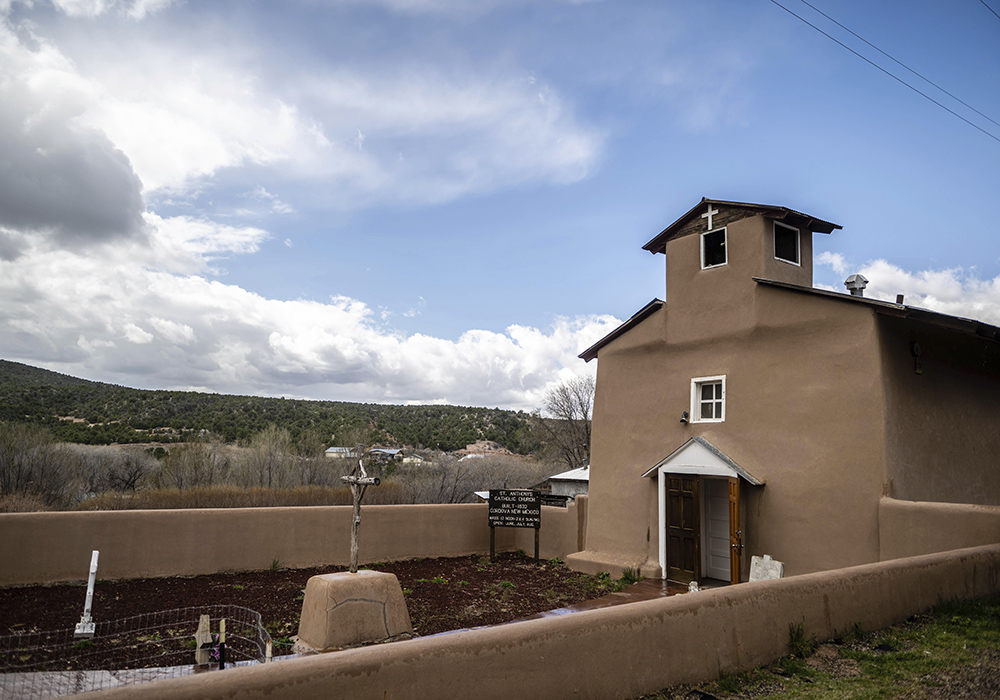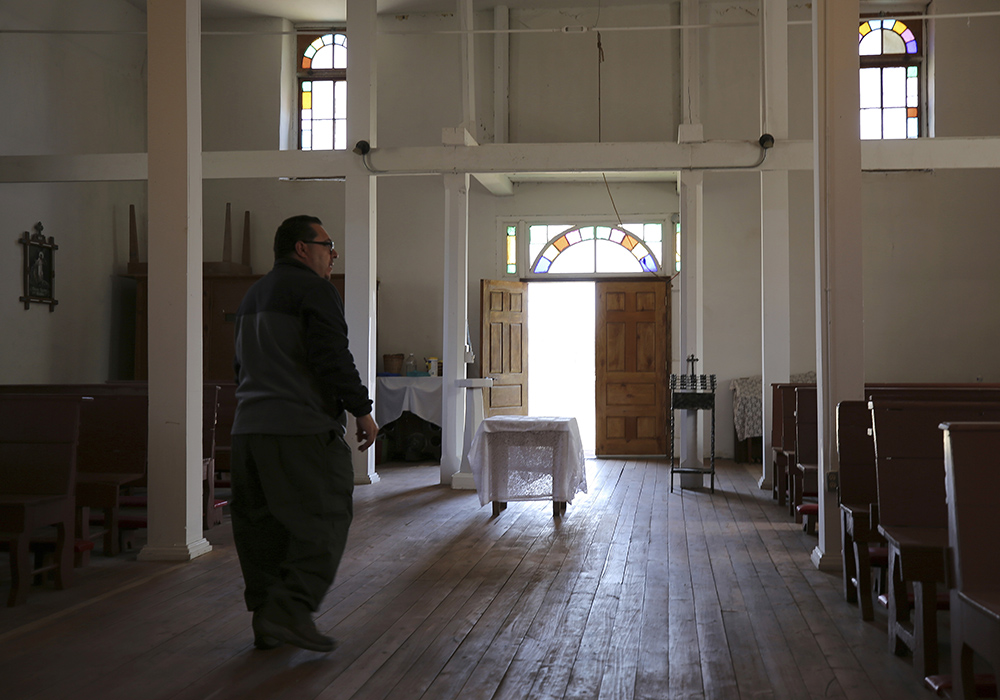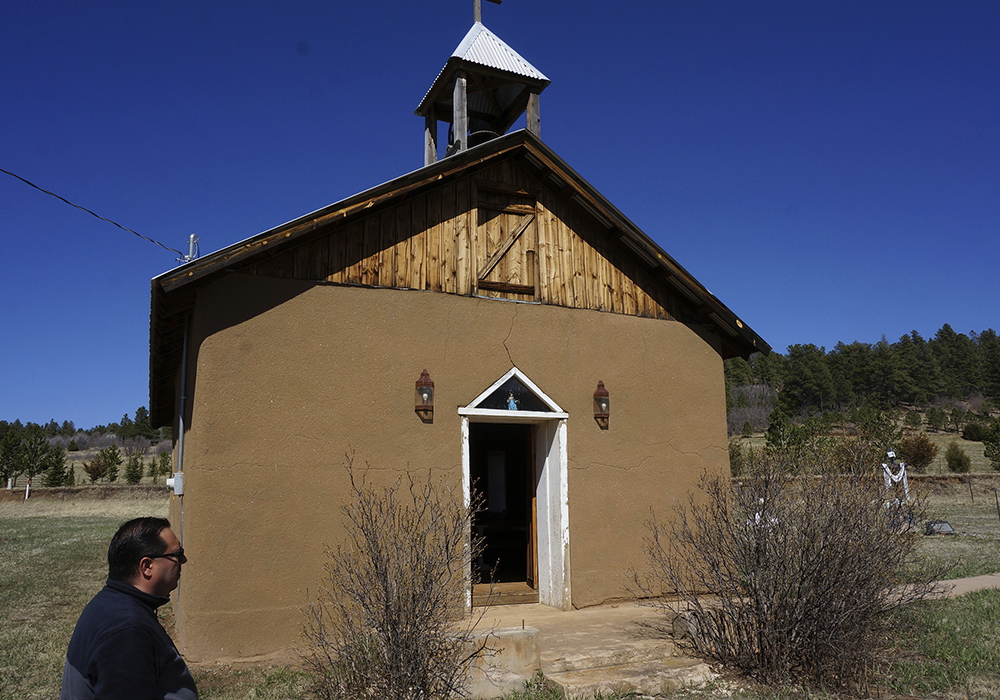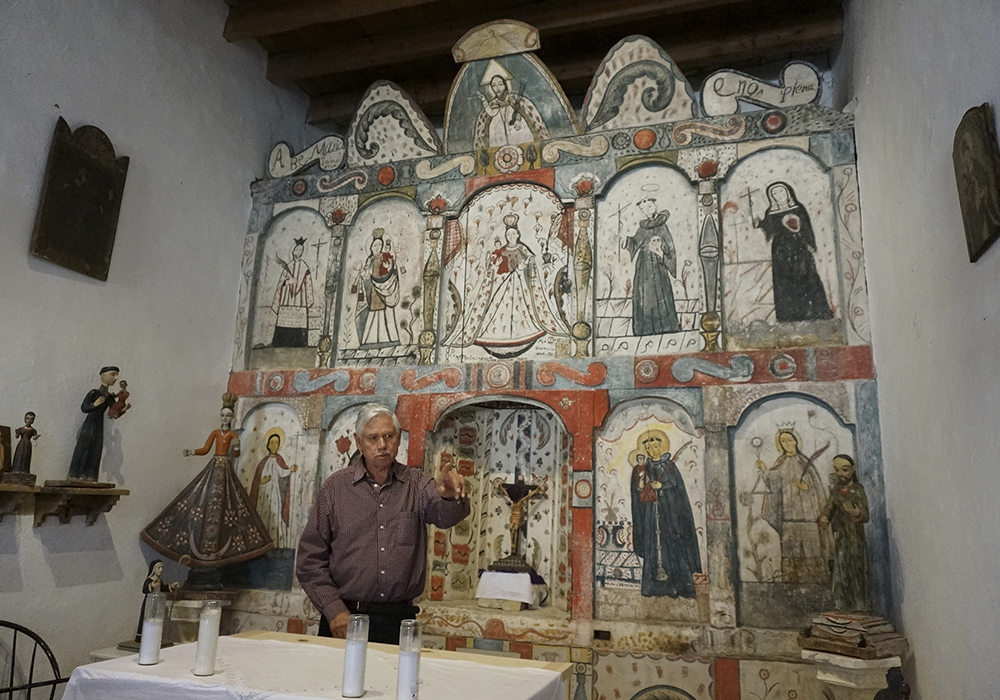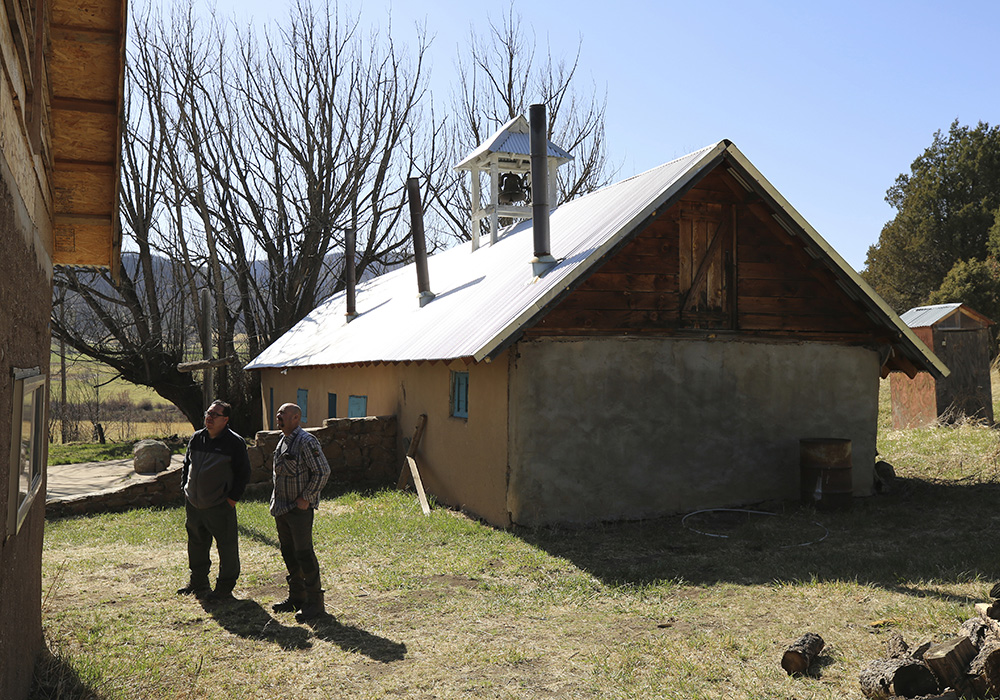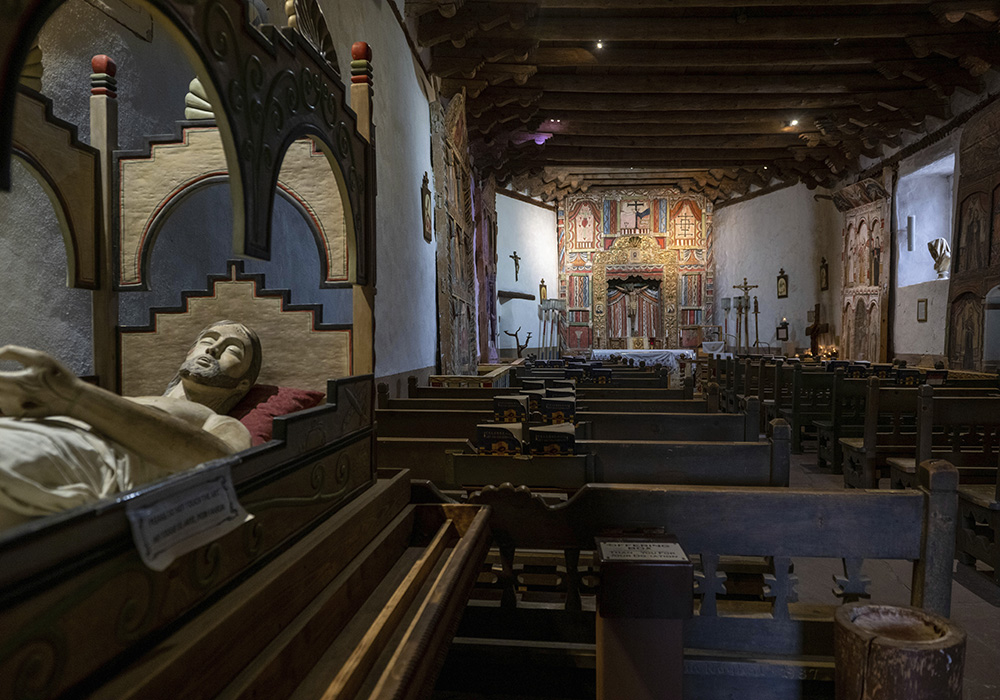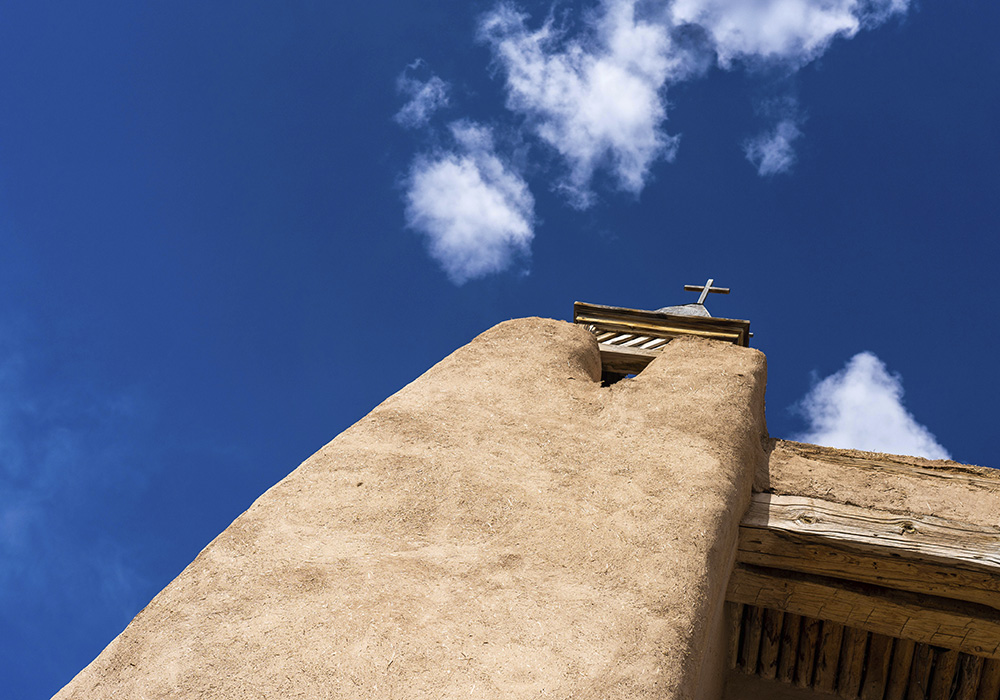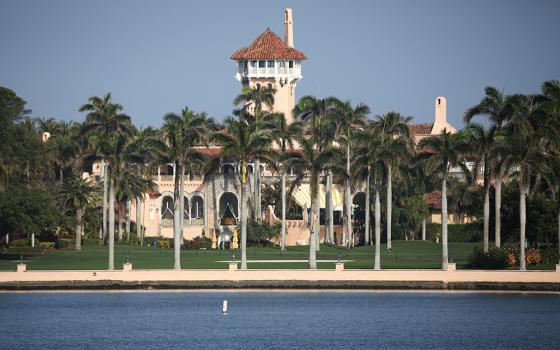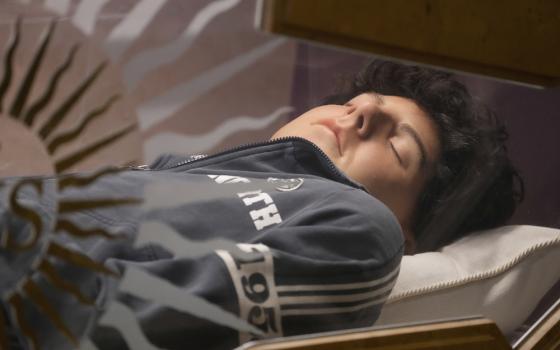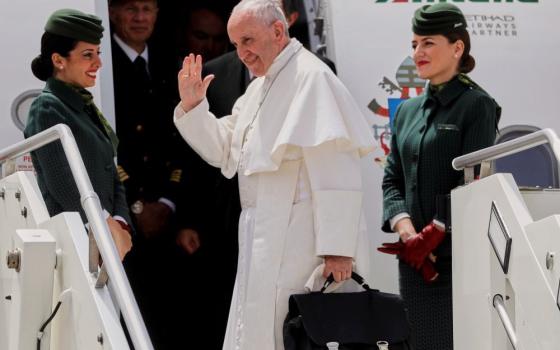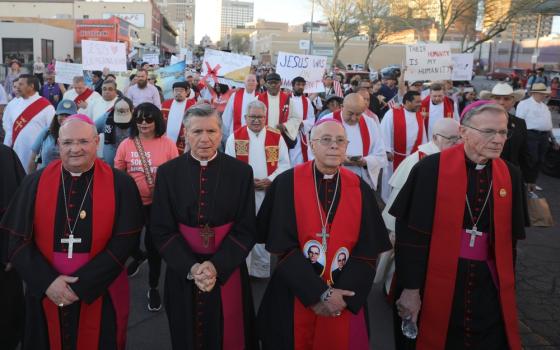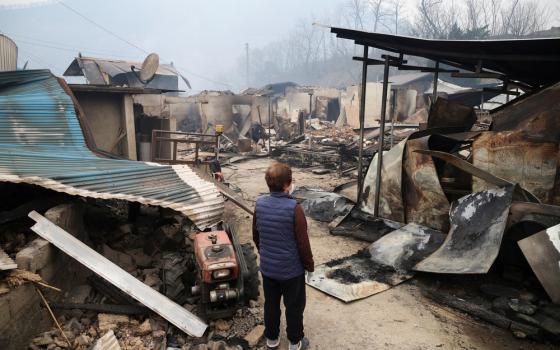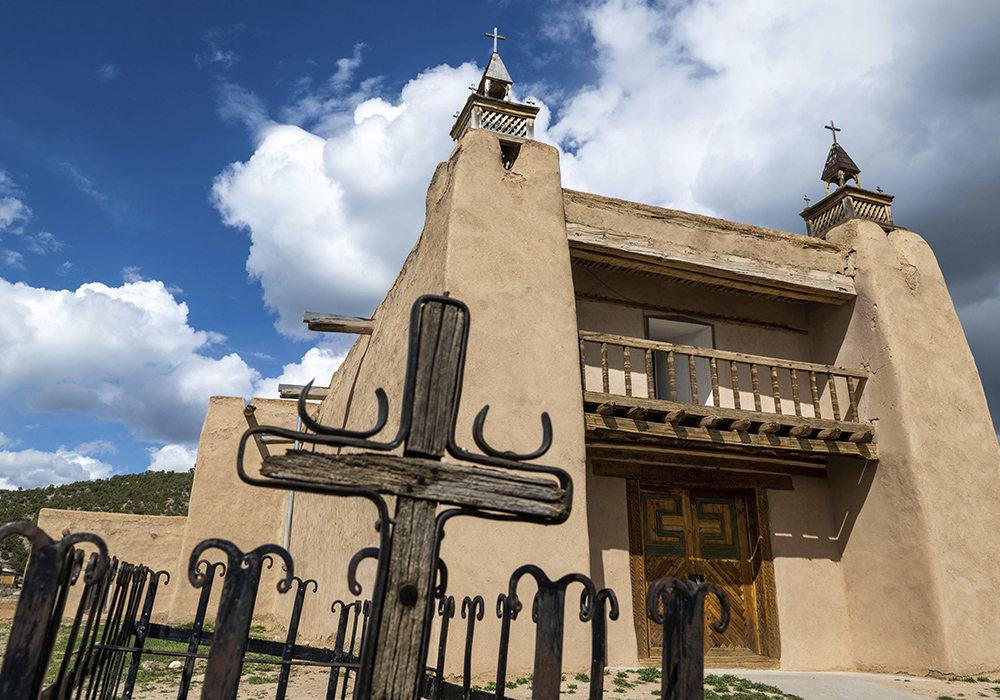
An exterior view of the San Jose de Gracia Catholic Church, built in 1760, April 14 in Las Trampas, New Mexico. Threatened by depopulation, dwindling congregations and fading traditions, some faithful are fighting to save their historic adobe churches and the uniquely New Mexican way of life they represent. (AP photo/Roberto E. Rosales)
Ever since missionaries started building churches out of mud 400 years ago in what was the isolated frontier of the Spanish empire, tiny mountain communities like Cordova relied on their own resources to keep the faith going.
Thousands of miles from religious and lay seats of power, everything from priests to sculptors to paint pigments was hard to come by. Villagers instituted lay church caretakers called "mayordomos," and filled chapels with elaborate altarpieces made of local wood.
Today, threatened by depopulation, dwindling congregations and fading traditions, some of their descendants are fighting to save these historic adobe structures from literally crumbling back to the earth they were built with.
"Our ancestors put blood and sweat in this place for us to have Jesus present," said Angelo Sandoval on a spring day inside the 1830s church of St. Anthony, where he serves as mayordomo. "We're not just a church, we're not just a religion — we have roots."
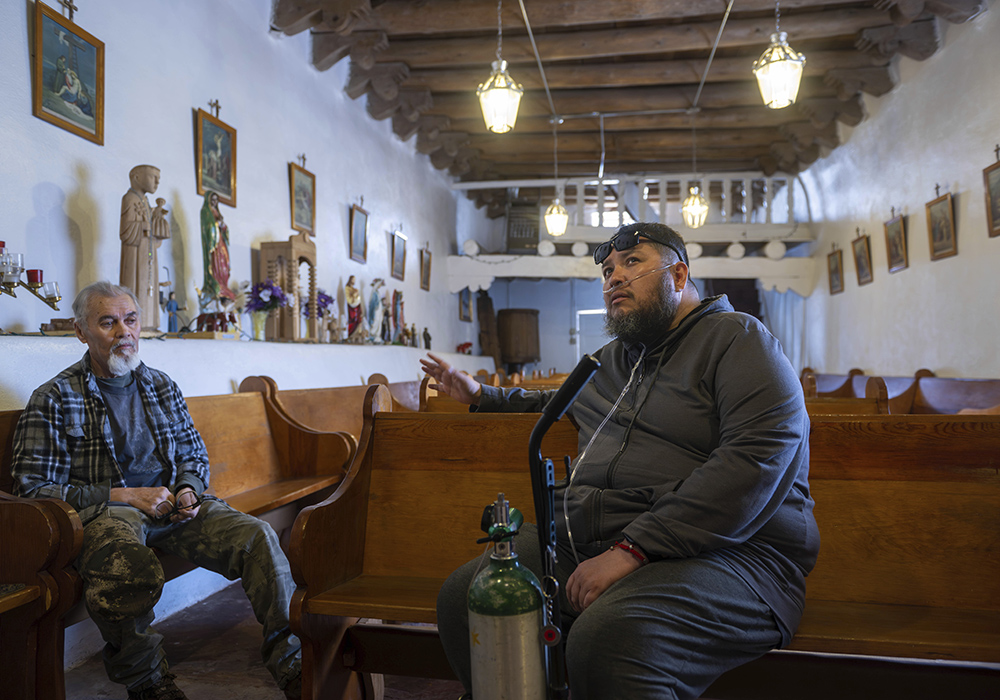
Angelo Sandoval, mayordomo or lay church caretaker, accompanied by his uncle, santero Jerry Sandoval, speaks while sitting inside St. Anthony's Catholic Church, April 14 in Cordova, New Mexico. (AP photo/Roberto E. Rosales)
These churches anchor a uniquely New Mexican way of life for their communities, many of which no longer have schools or stores, and struggle with chronic poverty and addiction. But it's becoming increasingly difficult to find the necessary resources to preserve the estimated 500 Catholic mission churches, especially since most are used for only a few services each year.
"When the faithful generation is gone, are they going to be a museum or serve their purpose?" said the Rev. Rob Yaksich, pastor of Our Lady of Sorrows in Las Vegas, New Mexico, which oversees 23 rural churches. "This old, deep-rooted Spanish Catholicism is experiencing serious disruption."
In the hamlet of Ledoux, Fidel Trujillo is mayordomo of the pink-stuccoed San José church, which he keeps spotless even though few Masses are celebrated here regularly.
"Our 'antepasados' (ancestors) did a tremendous job in handing over the faith, and it's our job now," Trujillo said in the characteristic mix of Spanish and English that most speak in this region. "I much prefer coming to these 'capillas' (chapels). It's a compass that guides where your heart really belongs."
Each mission church is devoted to a particular saint. When New Mexico's largest wildfire last spring charred forests less than 100 yards from San José church, and Trujillo was displaced for a month, he took the statue of St. Joseph with him.
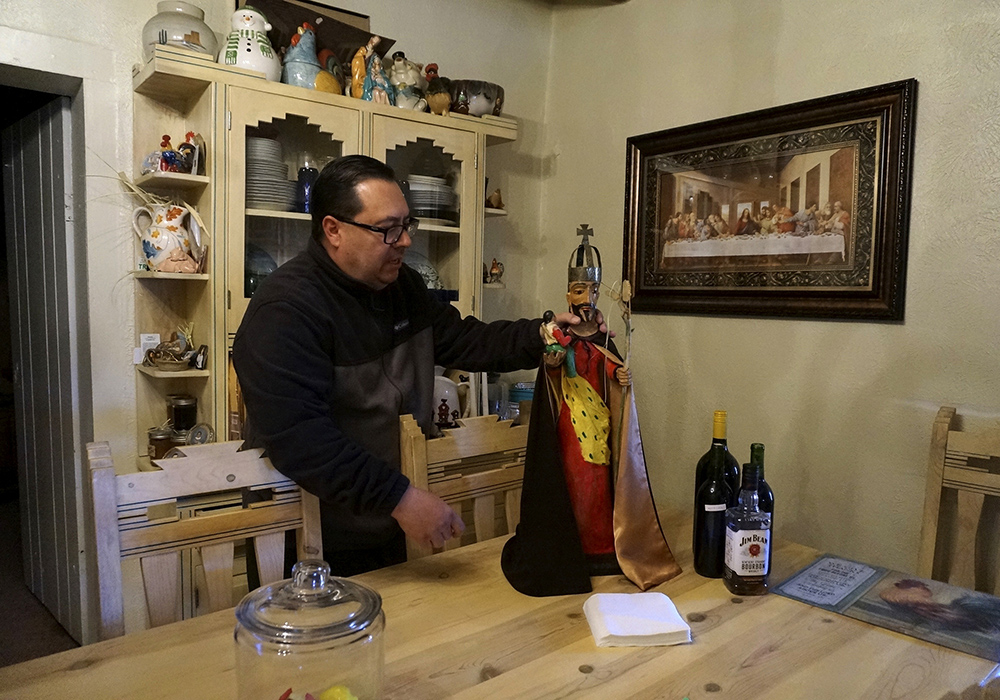
Mayordomo Fidel Trujillo shows a bulto, or wooden sculpture, of St. Joseph, that's kept for safekeeping at his aunt's home April 15 in Ledoux, New Mexico. Each mission church is devoted to a particular saint, for whom the community develops such veneration that the image is sometimes kept at the home of mayordomos for safekeeping and easier access. (AP photo/Giovanna Dell'Orto)
"Four hundred years ago, life was very difficult in this part of the world," explained Felix López, a master "santero" – the artists who sculpt, paint and conserve saint figures in New Mexico's unique devotional style. "People needed these 'santos.' They were a source of comfort and refuge."
In intervening centuries, most were stolen, sold or damaged, according to Bernadette Lucero, director, curator and archivist for the Archdiocese of Santa Fe.
But how much these expressive sculptures and paintings still matter to local communities is evident where they survive in original form, as they do at the mission churches in Cordova, Truchas and Las Trampas on the road from Santa Fe to Taos.
"Saints are the spiritual go-to, they can be highly powerful," said Victor Goler, a master santero who just completed conserving the altarpieces, or "reredos," in Las Trampas' mid-18th century church. "It's important for the community to have a connection."
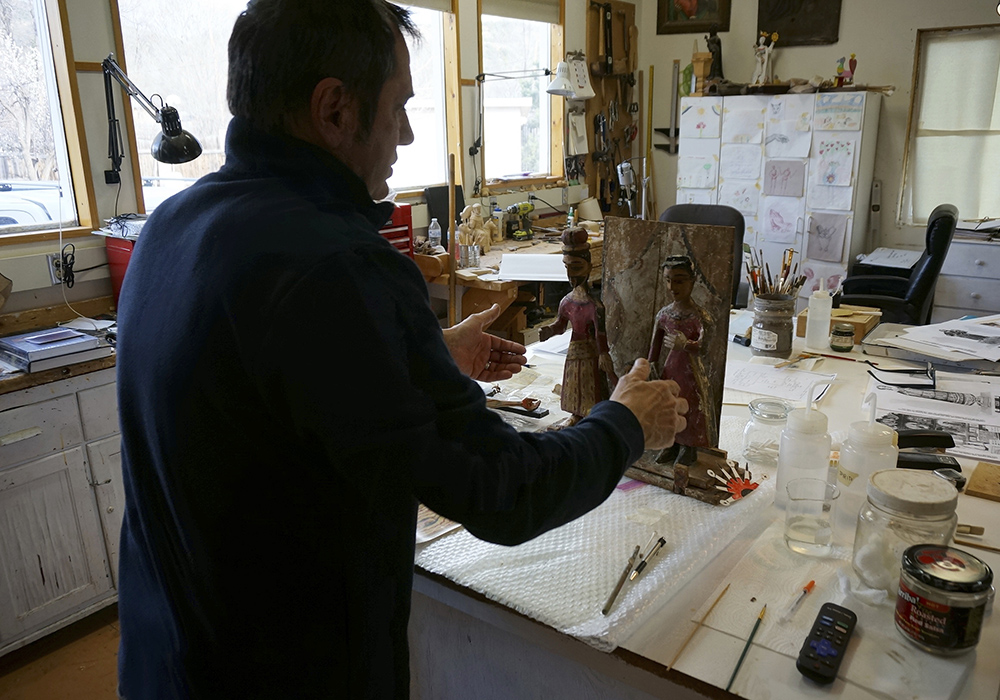
Victor Goler adjusts a holy family sculpture or bulto in his studio April 14 outside Taos, New Mexico. As a conservator and master santero — an artist trained in New Mexico's centuries-old tradition of religious sculpture and painting — Goler has worked on many historic and imperiled churches, helping to conserve their distinctive artistic patrimony. (AP photo/Giovanna Dell'Orto)
On a recent Sunday at Truchas' 1760s Holy Rosary church, López pointed out the rich decorative details that centuries of smoke and grime had hidden until he meticulously removed them with the absorbent inside of sourdough bread.
"I'm a devout Catholic, and I do this as meditation, as a form of prayer," said López, who's been a santero for five decades and whose family hails from this village perched on a ridge at 7,000 feet (2,100 meters).
Down the valley in Cordova, santero Jerry Sandoval also says a prayer to each saint before starting to sculpt their image. He then paints them with natural pigments and varnishes them with the sap of piñon, the stocky pine tree that dots the countryside.
He also helped conserve the centuries-old reredos at the local church, where many children come back for traditional Christmas and Easter prayers — giving hope that younger generations will learn to be attached to their church.
"They see all this," Jerry Sandoval said in front of the richly decorated altarpieces from St. Anthony church. "Lots of people call it tradition, but we call it faith."
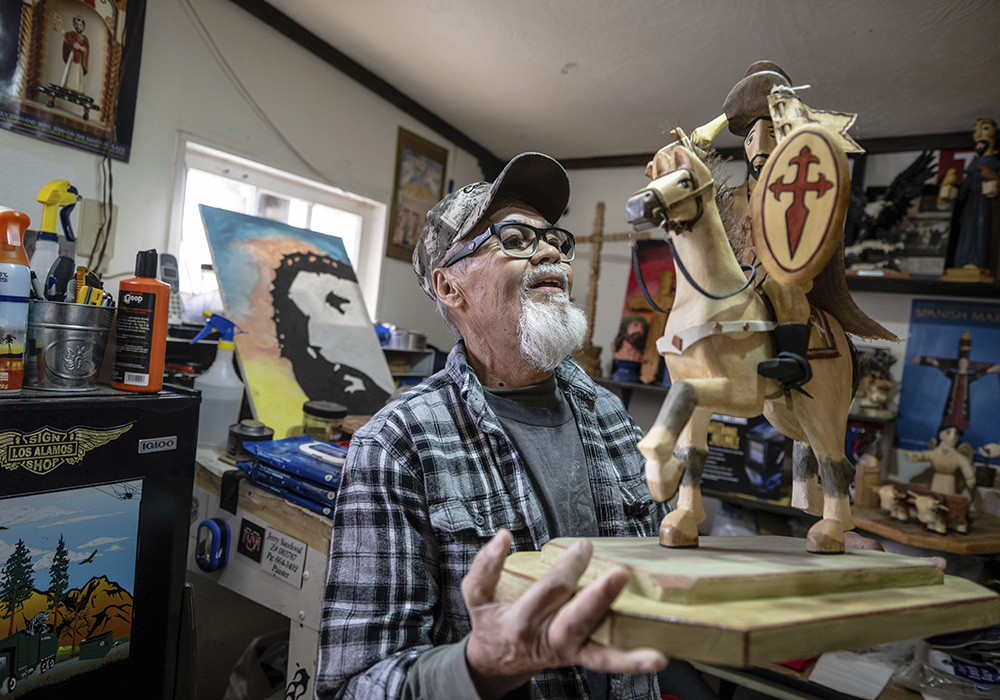
Santero Jerry Sandoval holds one of his bultos depicting St. James, in his studio April 14 in Cordova, New Mexico. Sandoval says a prayer to each saint before starting to sculpt their image out of pine, cottonwood or aspen. (AP photo/Roberto E. Rosales)
For the Rev. Sebastian Lee, who as administrator of the popular Santuario de Chimayó complex a few miles away also oversees these mission churches, fostering local attachment is a daunting challenge as congregations shrink even faster since the Covid-19 pandemic.
"I want missions to be where people can taste culture and religiosity. They're very healing, you're soaked with people's faith," Lee said. "I wonder how to help them, because sooner or later one mission is not going to have enough people."
The archdiocese's Catholic Foundation provides small grants, and several organizations have been founded to help conservation efforts.
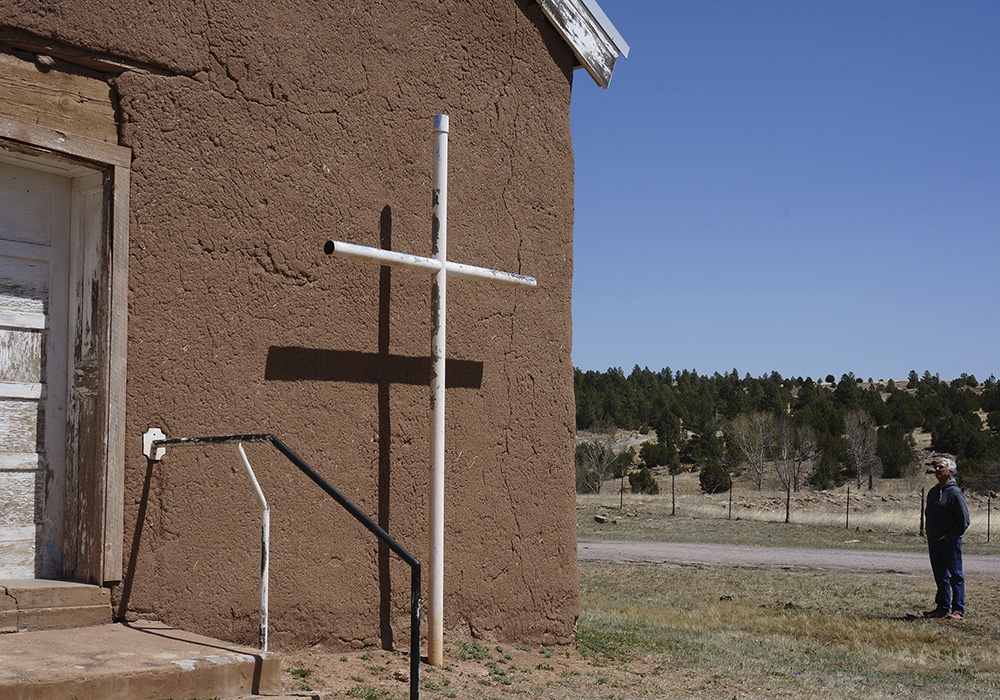
Frank Graziano stands in front of the 1840s San Geronimo Church April 15 in the mountain valley hamlet, west of Las Vegas, New Mexico. Graziano's nonprofit, Nuevo Mexico Profundo, is hoping to conserve the historic adobe church that's now in danger of collapsing, as are many remote chapels in this rural area with dwindling congregations and chronic poverty. (AP photo/Giovanna Dell'Orto)
Frank Graziano hopes his nonprofit Nuevo Mexico Profundo, which supported the Cordova conservation, can obtain the necessary permit from the archdiocese to restore the 1840s church of San Geronimo. Deep cracks break apart its adobe walls and bug nests buzz in a gaping hole by one of the windows.
The surrounding village is almost entirely depopulated, making it unlikely that the community will step in for the necessary upkeep. Exposed to rain and snow, adobe needs a fresh replastering of dirt, sand and straw every couple of years lest it dissolve.
That makes local buy-in and some kind of ongoing activity, even just funerals, fundamental to long-term preservation, said Jake Barrow, program director at Cornerstones, which has worked on more than 300 churches and other structures.
Advertisement
But with fewer priests and fewer faithful, taking some rural missions off the church's roster might be inevitable, said the Rev. Andy Pavlak, who serves on the archdiocese's commission for the preservation of historic churches.
"We have two choices: Either return to the community, or back to the earth they came from. We can't save them all," said Pavlak, who for nearly a decade ministered to 10 historic churches in Socorro County.
Running his hand over the smooth adobe walls he restored at the 1880s Santo Niño de Atocha chapel in Monte Aplanado, a hamlet nestled in a high mountain valley, Leo Paul Pacheco argued that the answer might hinge on the faith of future generations of laypeople like him.
"They still have access to the same dirt," Pacheco said as the adobe walls' sand particles and straw sparkled in the sun. "They will provide."
Associated Press religion coverage receives support through the AP's collaboration with The Conversation US, with funding from Lilly Endowment Inc. The AP is solely responsible for this content.
